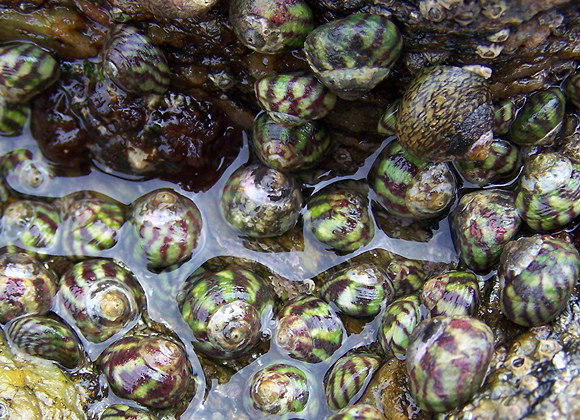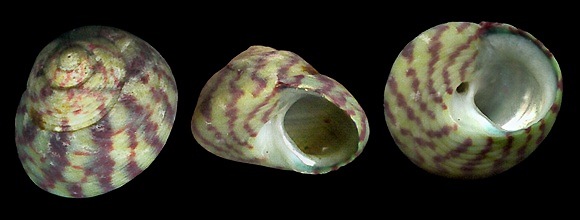
Grazer and deposit feeder in sheltered rocky interdidal grounds colonized with algae, often crowded in tide pools, down to circa 20m deep; lives also in estuaries (DORIS).
Original taxon: Trochus umbilicalis. Synonym: umbilicatus.
« Shell strong, subconic, depressed, with five nearly flat volutions, terminating in an obtuse apex, and defined only by a fine, thread-like suture; base of the body rounded at the margin; the whole shell covered by almost obsolete spiral striae, which are stronger on the somewhat flattened base; aperture compressed and angulated; inside perlaceous, reflecting deep green and crimson; outer lip flattened on the edge; umbilicus large, white, rounded at its edges, slightly wrinkled internally, and penetrating to the apex; colour white, livid, or greenish, with longitudinal, waved or zigzag, reddish-purple lines. […] The very highly iridescent reflections in the interior of the aperture is an uniform character of this species. » – T. Brown: Illustrations of the recent conchology of Great Britain and Ireland vol. I, London 1844, p.18.
2-3m deep, under stones, Málaga, Andalucia, S. Spain. 13mm.
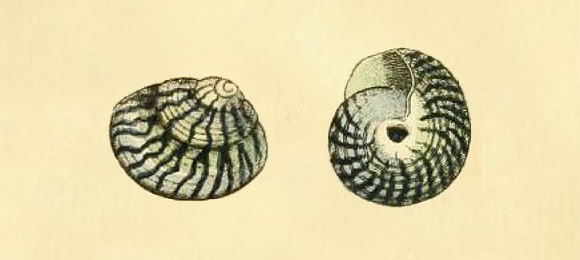
« The shell is thick and strong, size of a small grape, no ways pyramidal, but flattish, the body being only somewhat convex, and not lengthened. The base is set with fine distant circular striae. The mouth round and capacious ; its inside, except a few slight striae correspondent to some on the outside, is smooth and pearly ; the outer lip even and sharp ; the inner or pillar lip thick and oblique, and from the top of it arises a pretty large oblique white cavity that leads to the umbilicus, which runs deep, and is capable of admitting a common pin’s head. » – E. M. da Costa: op. cit. p.46.
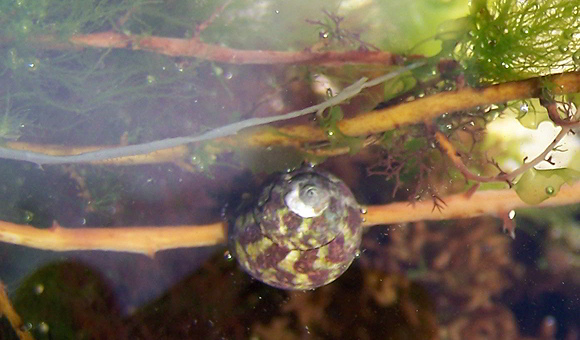
« The body and turban have five whirls, not produced or lengthened, but only just rising obtuse on one another, so as to form a small convexity. They have the same circular striae as on the base, and are only separated from one another by a furrow. The shell is whitish, or fullied with ashen, very beautifully marked with purplish brown oblique stripes ; they run lengthways of the shell, are thick set, and very regular, and by their obliquity form a kind of radiation. When nicely observed, some stripes are furcated. »
On Sargassum muticum (Yendo) Fensholt, 1955.
Tide pool, Groix island, SW. Brittany, NW. France.
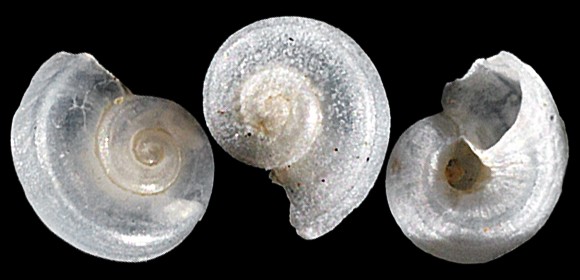
Original picture provided by Gert Lindner – (CC BY-NC-SA).
